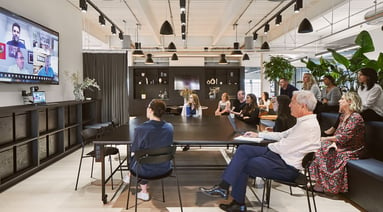A “meeting of the minds” on hybrid work: Unispace’s annual global survey of 10,000+ employers and employees

Working habits have evolved, yet the office itself hasn’t kept up: Employees now seek workplaces that foster individual focus, rather than reserve concentration working from home
September 30th 2024 – After years of discord around hybrid schedules, the latest global survey from leading design-build firm Unispace shows that employees and employers have finally found an acceptable middle ground.
According to the survey report From Restrictions to Resilience, 95% of employers globally are happy with their current hybrid working arrangement, while 87% of employees feel the same. In the past year, employees globally have ceded to work nearly a half-day more than before, now expected to be in the office 3.7 days per week. While employees emphasize that “building social connections” and “face-to-face collaboration” are among top office benefits, they also expect the opportunity for focus work so they can “feel more productive” — and this is where the current office is missing the mark.
According to the survey, that’s a concern for employers as well. They have less confidence this year (76%) than in 2023 (81%) that their workplace enables “employees to be innovative,” indicating that the office needs to further evolve to create an environment where their workers can thrive.
Striking the balance between concentration and connection
While face-to-face collaboration remains their top incentive for being in the office, in reality, employees spend nearly two-thirds (64%) of their time at their desks doing focused work. However, they’re finding that limited space options, noise and interruptions often disrupt their focus—among several challenges highlighted in the survey results.
To mitigate these challenges, the report recommends a combination of furniture and workplace configurations that cater to various tasks and working styles. Employers should consider designating quiet, peaceful spaces for concentration or rejuvenation, as well as more dynamic areas for connection and teamwork. For example, Bread Financial, a leader in data-driven payment, lending and saving solutions, created ‘zones’ to support varying employee work styles, enabled by a phone app that allows staff to conveniently book a desk when they need to do focus work.
Narrowing generation gaps in the office
Younger generations (ages 18-34) prefer remote work compared to their older counterparts, according to the survey. However, they value office ‘perks’ intended to entice them back to the office more than other generations. For example, younger generations see the most benefit the most from mentorship — 78% would be happier to spend more time in the workplace if they had access to it. And nearly 90% of them said they would happily spend more time in the office if their employer provided subsidized travel, offered free lunches or access to amenities like a gym.
“Employers have to work extra hard to encourage their Gen Z employees—ostensibly their future workers—to spend time in the office,” said Tydeman. “Based on our work with clients, that means ‘oversampling’ your Gen Z employees’ needs to create a space that works best for them.”
Creating welcoming spaces that inspire
To enhance the office’s appeal for all generations, the report notes that spaces must foster a sense of employee belonging and identity, reflect organizational values and allow for flexible start times. To put a finer point on it, 72% of employees would be happier to spend more time in the office if their workplace had spaces that connect them to the organization’s brand, culture and values.
People want to work in spaces that are bright, inviting and engaging, that celebrate not only the organization but the diverse individuals within it. For example, Downstream, Unispace Group’s experience design agency, transformed the New York headquarters for Google’s Global Business Organization in St. John’s Terminal to include a mix of spaces, enhanced by sculptural elements, QR code-driven story plaques, and advanced workplace technologies, to foster DEIB (diversity, equity, inclusion, and belonging) and accelerate innovation.
Forbes
Global News Wire
Citybiz
The Economic Times
ConnectCRE
Commercial Property Executive
Work Design Magazine
Entrepreneur India
Architecture and Design
India Times
AsiaOne
Yahoo Finance
Fortune


